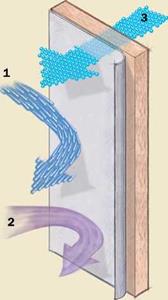Making Sense of Housewraps
■ BY FERNANDO PAGES RUIZ
|
W |
hen I started building houses nearly 30 years ago, we lapped lightweight #15 asphalt – or rosin-impregnated building paper directly over the stud framing before installing the siding. Nowadays, concerns with energy-efficient construction and moisture infiltration have focused a great deal of attention and no small amount of high-tech chemistry on this thin layer of paper. Although some builders still advocate the felt-paper barriers of yesteryear, most have switched to plastic-based housewraps, products designed to stop air infiltration and wind-driven rain while allowing water vapor to evaporate—a great concept.
However, like everything high-tech, new solutions come with new problems. The range of choices and the precise installation requirements of modern housewraps challenge builders with terms like spun – bonded, polyolefin-based moisture, and air-infiltration fabric. Even if the technical terminology is hard to remember, learning how to install these products correctly is important. Yet a quick look around a construction site reveals that most builders, with thirty years or with three behind the ham
mer, are having a hard time handling this new technology.
There’s plenty of confusion surrounding weather-resistive barriers. Many homeowners and builders don’t know which product to choose, some builders never learned how to install it correctly, and many have no idea what housewrap does in the first place.
Placed beneath the siding, housewrap is a second layer of defense for your home. When installed properly, it performs three basic functions (see the drawing on the facing page).
First and foremost, housewrap acts as a backup barrier that keeps water off the structural sheathing and framing. Properly installed siding is the first line of defense, but sometimes wind-driven rain and snow still find a way through. Housewrap also functions as an air barrier that stops hot – and cold-air movement through the wall cavity. As long as joints are sealed properly, house – wrap is designed to cut utility costs and

 increase comfort by reducing air infiltration and potential drafts.
increase comfort by reducing air infiltration and potential drafts.
The real magic of housewrap lies in its third function: allowing the free passage of water vapor so that wall cavities and framing lumber can dry to the outside of the building, reducing the threat of mold and rot. Without this feature, installing housewrap would be like putting a thick raincoat over your house: great for keeping out the rain, but terrible at releasing water vapor from within. Instead, housewraps are designed to act like a Gore-Tex® jacket, allowing water vapor to pass through the building envelope in case moisture problems arise.






Leave a reply